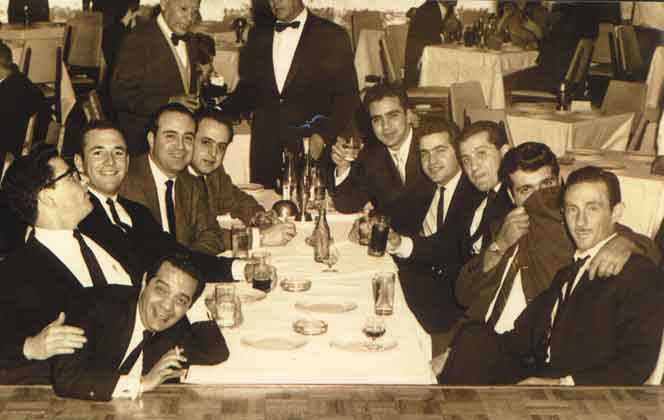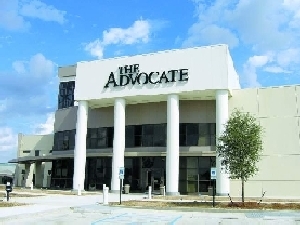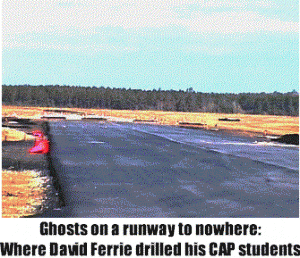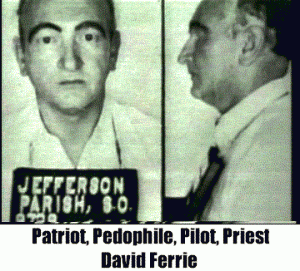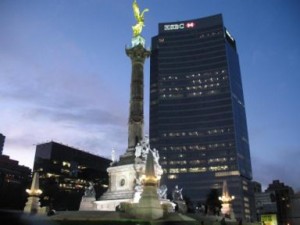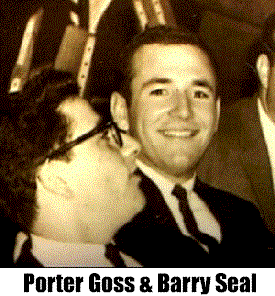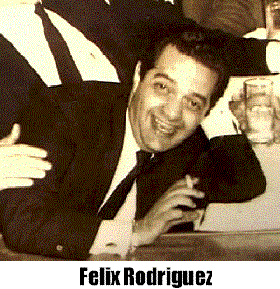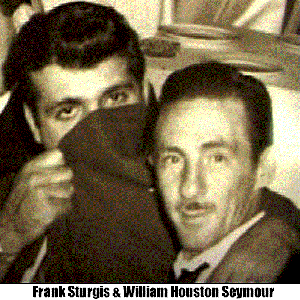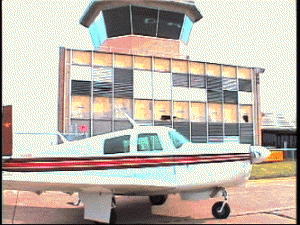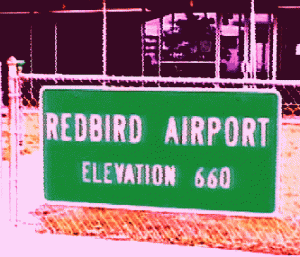Barry Seal, the CIA camp in Lacombe, & the JFK Assassination -part 1 of 2
It was in the sun-drenched Albuquerque study of one of America's most prominent historians—a Guggenheim Fellow and a National Book Award winner—that I first heard what I later came to think of as "The Question."
Enroute from Los Angeles to New Orleans, where I would spend the next two years researching and writing a book about renowned CIA pilot-turned-infamous drug smuggler Barry Seal, I stopped to visit Dr. Roger Morris and Sally Denton, the writers who first brought serious national attention to the CIA operation in Mena, Arkansas led by Oliver North, and Barry Seal.
We were drinking cokes in the warm sun and exchanging tidbits of information each of us had gleaned about our common subject, when at one point Morris leaned forward.
“What have you heard,” he asked, “about Barry Seal having flown a get-away plane out of Dallas after the Kennedy assassination?”
I stared at him blankly. I replied that I didn’t know there had even been a get-away plane. And that was the end of it. The conversation quickly moved on. But the moment changed my life. In the two years of research which followed, I never forgot the question.
Months later, while collecting old news clippings in Barry’s hometown of Baton Rouge, Louisiana, I struck up a conversation about Seal with the morgue librarian at the Baton Rouge Advocate. She had a kind of smoky whiskey voice you generally don't associate with librarians.
"Its another world, New Orleans"
"Hell, she said, “a good 20 years. I've been remarried for ten."
Later, after I heard a story about Barry Seal from John Odom, a friend and classmate of Seal’s in high school, I began to realize that the rumor might be something more than that. While it wasn’t common knowledge, in certain circles in Louisiana it is what is known as an “open secret.”
Big shout out to Oliver Stone
Even if you’re not a JFK assassination researcher—and I wasn’t—you know who Ferrie was. Everyone’s seen Joe Pesci’s brilliant portrayal of Ferrie in Oliver Stone’s JFK. Many recall that Ferrie – just forty-eight hours after Kennedy died—was brought in for questioning on suspicion that he had been involved in the assassination.
Odom watched them confer, he said, and saw Ferrie point to the 50-or-so wooden crates staged next to the tarmac.
On the way back to Baton Rouge, Barry Seal told him that he was working for Ferrie, who he said was "CIA.” (Ferrie's CIA link was confirmed by Victor Marchetti, former Deputy Assistant to Richard Helms, who testified that Helms disclosed, in executive discussions during the Garrison investigation, that Ferrie had in fact been employed by the CIA.)
“Seal said he making $400 a week flying "runs" of crates of weapons and ordinance for Ferrie,” said Odom. He asked me, How'd you like to make that kind of money?”
Odom said he told Barry, 'I'll think about it.' But they never discussed it again. Decades later, the incident remains puzzling to Odom. "Our dad made about $400 a month back then, and we weren't poor, but I was stunned and didn't know what to say.”
Translated into today's money, Barry Seal was making $2500 weekly…on the weekends.
A piece of real history slipped through the cracks
Then a fortuitous happenstance brought me a photograph that spoke volumes about Barry Seal's career, and the people involved in the JFK assassination.
Seal left it to his wife, Debbie, now his widow. And despite the 7-man "clean-up crew" from the State Department that came down from Washington to her home and combed through all of Barry's records in early 1995, it is still in her possession. The photo, which she considered a keepsake, remained untouched in her safe.
The photo was in a cardboard frame of the kind used by nightclubs and tourist attractions, with the date it was taken, January 22,1963, stamped on the back. It was taken in the nightclub of the Aristos Hotel in Mexico City’s Zona Rosa.
At the time the photo was taken, the CIA's covert action chief in Mexico City was David Atlee Phillips. Philips, AKA Maurice Bishop, reportedly met with Oswald in Dallas before the assassination.
The photo shows a group of ten men, wearing black suits and skinny ties, drinking around a table. They appear to be a mixed group of Cuban exiles, Italian wise guys, and square-jawed military intelligence types.
Identifying the men in the photo took months. And when I had, I realized that it is the only extant photograph of the members of the CIA’s super-secret assassination squad known as “Operation Forty."
A young (24-year old) Barry Seal is seated third from left. Seated to Seal’s right is former CIA chief Porter Goss. Front left, beside Goss, is the notorious Cuban "freedom fighter" Felix Rodriguez. Rodriguez, a vice cop under the corrupt Mob-run Batista regime in Cuba, later became an Iran Contra operative and a confidant of the first George Bush.
Felix Rodriguez has long been known to be one of the CIA's most vicious assassins. According to law enforcement authorities, he keeps Che Guevara's hands in a jar atop his dresser.
On the other side of the table, the only celebrant displaying any regard for tradecraft is covering his face with his sport coat. However, his swept-back “Big Wave in Hawaii” pompadour made him fairly easily identifiable as Frank Sturgis. Sturgis has often been mentioned in connection with the JFK assassination.
Sturgis will later become famous as one of the Watergate burglars.Beside him, front right, is a man well-known among Kennedy assassination researchers. William Seymour was the New Orleans representative of the Double-Chek Corporation, a CIA front used to recruit pilots (like Seal). Researchers identify Seymour as the man said to have impersonated Lee Harvey Oswald, while Oswald was out of the country.
It is certainly a well-connected group. Just the fact that the man who will become the biggest drug smuggler in American history had been consorting back in 1963 with a man whose job was recruiting pilots for the CIA makes allegations of CIA involvement in the drug trade far more than just another conspiracy theory.
So, if there had been a get-away plane flown out of Dallas after the Kennedy assassination—and assuming there had been an authentic investigation into the assassination, which there was not—Barry Seal would have been high on the list when authorities told the police to call in the “usual suspects.”
But that puts the cart somewhat in front of the horse. Is there evidence that there was a get-away plane? The answer is yes.
Three men in suits at Redbird Airport
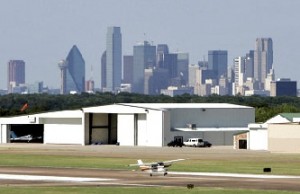 At about 1:00 P.M. that same afternoon, half an hour after the president was shot, neighbors who lived along the road that runs by the Redbird Airport, about 10 miles southwest of downtown Dallas, began calling the police. A small private plane, they reported, was behaving very strangely.
At about 1:00 P.M. that same afternoon, half an hour after the president was shot, neighbors who lived along the road that runs by the Redbird Airport, about 10 miles southwest of downtown Dallas, began calling the police. A small private plane, they reported, was behaving very strangely.
For an hour it had been revving its engines, not on the runway, as per usual, but parked at the end of the airstrip on a grassy area next to the fence. The noise was so loud it prevented nearby residents, glued to their TVs for the news about the terrible event downtown, from hearing.
The police, perhaps understandably, were too busy to check it out. The question became moot when shortly thereafter the plane took off.
An FBI file of March 10, 1967, describes statements made by Louis Gaudin, the government's air traffic control specialist at Redbird airport, who recalled observing three men in business suits board a Comanche-type aircraft at about 2:00 P.M.
Thirty-seven years later, I tracked down Louis Gaudin in retirement in the tiny town of Long Branch, Texas. “I filed that report in ’67 for only one reason,” Gaudin told me. “Sometime in 1967 I received a visit from an Assistant District Attorney in (New Orleans District Attorney) Jim Garrison’s office.”
“He showed me pictures of four possible pilots involved in the incident that day. One was a weird-looking character with a funny-looking wig. Then, shortly thereafter I saw on the news that David Ferrie had committed suicide, said Gaudin.
“That’s when I smelled a rat.”
Redbird Airport (today Dallas Executive Airport) is a small airfield between Dallas and Fort Worth. But it wasn’t just any old airport.
“The FAA had its general aviation headquarters there, said Gaudin. “Howard Hughes had a huge old WWII hanger there, with heavy security. People from Wackenhut all over the place. And there were the Porter planes from General Harry Byrd’s outfit.”
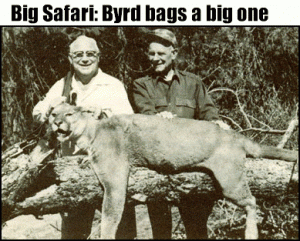 General D. Harry Byrd’s links to the Kennedy assassination begin with the fact that he owned the building, the Texas School Book Depository, from which Kennedy was supposedly gunned down.
General D. Harry Byrd’s links to the Kennedy assassination begin with the fact that he owned the building, the Texas School Book Depository, from which Kennedy was supposedly gunned down.
Then, too, he founded an aircraft company that became one of the largest U.S. defense contractors during the Vietnam War, Ling-Temco-Vought (LTV), which also—and perhaps not coincidentally?—tested missiles at the Venice Airport in the late 1950’s and early 1960’s.
“What had happened was this,” he continued. “I was an air traffic controller working in the tower at Redbird that day. When I came on shift at 2 PM, we received a bulletin to report any suspicious activity immediately to an FAA Security number. And we kept calling that number all afternoon, but got nothing but a busy signal. And then, after we heard they had caught the ‘lone gunman,’ I guess they called it, we stopped calling, and let the matter drop.”
From his perch atop the control tower, Mr. Gaudin, between handling twenty or thirty flights into and out of the airport an hour, had noticed something suspicious about three well-dressed men in business suits standing, along with several suitcase, beside a Comanche painted green-and-white.
So suspicious was he, Mr. Gaudin related, that when the plane took off on runway 17, he asked the pilot if he needed any assistance. The pilot said no. Gaudin asked which way the plane was heading. The pilot stated south.
Gaudin watched as the plane flew south for two miles, then made a hard left, and then flew north to Love Field.
The pilot had lied.
Suspicions aroused, Gaudin went over to the control tower’s receiver and listened as the plane made an approach and landed at Love Field, eight miles north of Redbird.
An hour later, the plane was back at Redbird. This time only two people were aboard. The third passenger—let’s call him the shooter–had been left at Love Field.
James Garrison, American hero
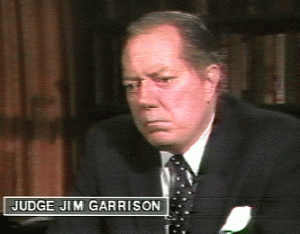 And that’s where the matter rested until Garrison’s investigator’s came calling.
And that’s where the matter rested until Garrison’s investigator’s came calling.
Then, after Gaudin became alarmed at the death of a man whose picture he had just recently been shown, he called the FBI, and filed the report which, he said, became something of a burden to him for the rest of his life.
“There was no Freedom of Information Act back then,” he says today. “That’s what’s created some problems for me.”
This would be just a ‘suspicious sighting’ except for something that happened later, which clearly indicated to Gaudin that he was a witness to something he had no business seeing.
From the control tower, he says, he was too far away to be able to identify anyone who boarded the plane. But there was one person who could: Merrit Goble, who ran the fixed-wing operation, TexAir, at Redbird Field.
“Merrit and I were friends,” Gaudin relates. “So one day, after filing the FBI report, I went down to see if the FBI had been by to visit him as well. They hadn’t, he told me. So I asked him if he had anything, any gas receipts, any record of the fueling of the plane in question. And Merit acted very strangely. He told me, in effect, that it was none of my business. He said, ‘I will only answer questions from a bonafide law enforcement authority.’”
“I always thought that was strange: ‘I will only answer questions from a bonafide law enforcement authority.’ Because like I said, we were friends.”
Merrit Goble died last year, taking any secrets he possessed about the suspicious plane to his grave.
Means, Motive, Opportunity
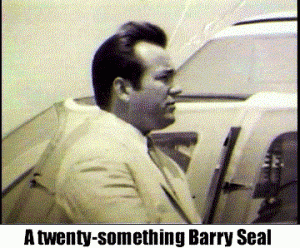 Was Barry Seal at the controls of the plane that took off from Redbird Airport on November 22 1963? We’ll never know for sure. But lacking an eyewitness willing to come forward and enough of a survivalist to live to tell his tale, we base a “yes” answer on his association with—and proximity to—the major players whose names get bandied about in connection with the assassination.
Was Barry Seal at the controls of the plane that took off from Redbird Airport on November 22 1963? We’ll never know for sure. But lacking an eyewitness willing to come forward and enough of a survivalist to live to tell his tale, we base a “yes” answer on his association with—and proximity to—the major players whose names get bandied about in connection with the assassination.
The central thesis of most writers on the assassination is that the Kennedy assassination was the work of the Mafia, elements of the CIA, and right-wing Cuban exiles aligned with Guy Banister, Clay Shaw, and David Ferrie, all of whom were CIA-connected. Not to mention Lee Oswald, who had formed an alliance with the U.S. intelligence community as a young man in the Civil Air Patrol with David Ferrie.
Barry Seal knew them all.
He was a known associate of the ‘usual suspects’: David Ferrie, Carlos Marcello, Guy Banister, and Grady Partin. He was a gunrunner to Cuba, and a veteran of the Bay of Pigs. And his participation in Operation 40, the CIA’s assassination squad, the blackest of black ops, as attested by the photo taken in Mexico in January 1963.
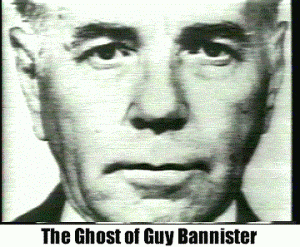 About one longtime associate of Banister and Ferrie (Murray Kessler) who was busted with Barry in 1972, one DEA agent said, “He (Kessler) had a lot of familiarity with that group of ‘yahoos’ in New Orleans; that’s how I figure he met Barry, who was known to have been involved with Guy Banister and Ferrie back then too.”
About one longtime associate of Banister and Ferrie (Murray Kessler) who was busted with Barry in 1972, one DEA agent said, “He (Kessler) had a lot of familiarity with that group of ‘yahoos’ in New Orleans; that’s how I figure he met Barry, who was known to have been involved with Guy Banister and Ferrie back then too.”
Moreover, Barry Seal was a spectacular pilot, one of the best alive.
I believe Seal flew that ‘getaway’ plane out of Dallas; and that during his often-acrimonious dealings with his superiors, his participation in the JFK hit remained his ‘ace in the hole’ for the rest of his life.
But where did the shooters come from? I’ll take that up tomorrow, in “The Camp in Lacombe.” As far as I know, I’m the only investigator in recent times who was able to locate—and visit—the site of the CIA’s secret camp for assassins in Lacombe, Louisiana.
What do the 9/11 attack and the Kennedy assassination cover-ups have in common?
Mis-direction. On 9/11, New York City was where most of the killing took place. It took maybe an hour. In Venice, Florida, where the key conspirators got together, they spent more than a year. Yet there’s been endless talk—leading absolutely nowhere—about thermite, about holograms, about Building 7. And its all hooey, or, to use the technical term, disinformation.
Why I’m so sure is because I was the only investigative reporter at the biggest 9/11 crime scene—Venice—that wasn’t reduced to rubble. And I was continually made aware that I didn’t belong—and wasn’t wanted—there.
The Kennedy assassination set the pattern. Debating the minutiae of Dallas—the ‘magic bullet theory,’ the changing parade route, the standing down of military intelligence, and dozens of other unexplained anomalies—has proven only that a conspiracy had indeed taken place.
But it was never going to put anyone in jail. Because the conspiracy was elsewhere. In New Orleans, Chicago, Miami, on No Name Key, and. most especially, in Lacombe, Louisiana, where the CIA kept a secret camp which trained assassins.
Moreover the conspirators were pros. The Kennedy assassination was their calling card. Unlike the “big find” about the identity of the second shooter which one prominent author is currently using to flog his book—who was told by a friend of a friend of a guy who had it on good authority that so-and-so, who’s now, regrettably, dead, was in on the hit— they didn’t disappear from history after November 23, 1963.
For the next several decades, the people who killed JFK made history. In Laos, and Cambodia, at the Watergate complex, and in the drug trafficking scandal that was mis-named Iran Contra.
They were people like Barry Seal.
Tags:
Replies to This Discussion
"Destroying the New World Order"
THANK YOU FOR SUPPORTING THE SITE!
Latest Activity
- Top News
- ·
- Everything
What was the Significance of the F-94 C and What role in History?
FLUORIDEGATE: An American Tragedy. a film by Dr. David Kennedy
Rendezvous With The Unknown
Shadows in the Wind
Mossad: we create a pretend world, we are a global production company... the world is our stage
The Alvin II Encounter: Was There A Living Dinosaur Involved?
All In The Family | Mike Meets Archie For The First Time | The Norman Lear Effect
entitlement
Death Threats for Assisting ICE?
'They’re Waiting for Us to Die': Area 51 Veterans Plead for Trump’s Help | Elizabeth Vargas Reports
Switch to the Mobile Optimized View
© 2025 Created by truth.
Powered by
![]()
